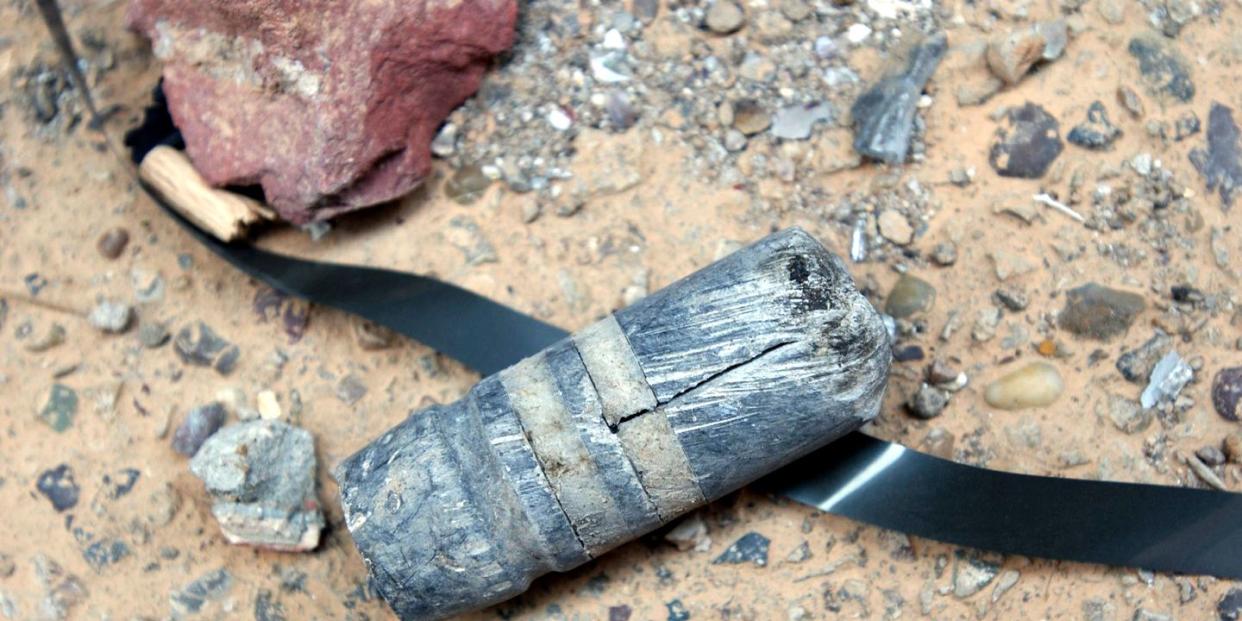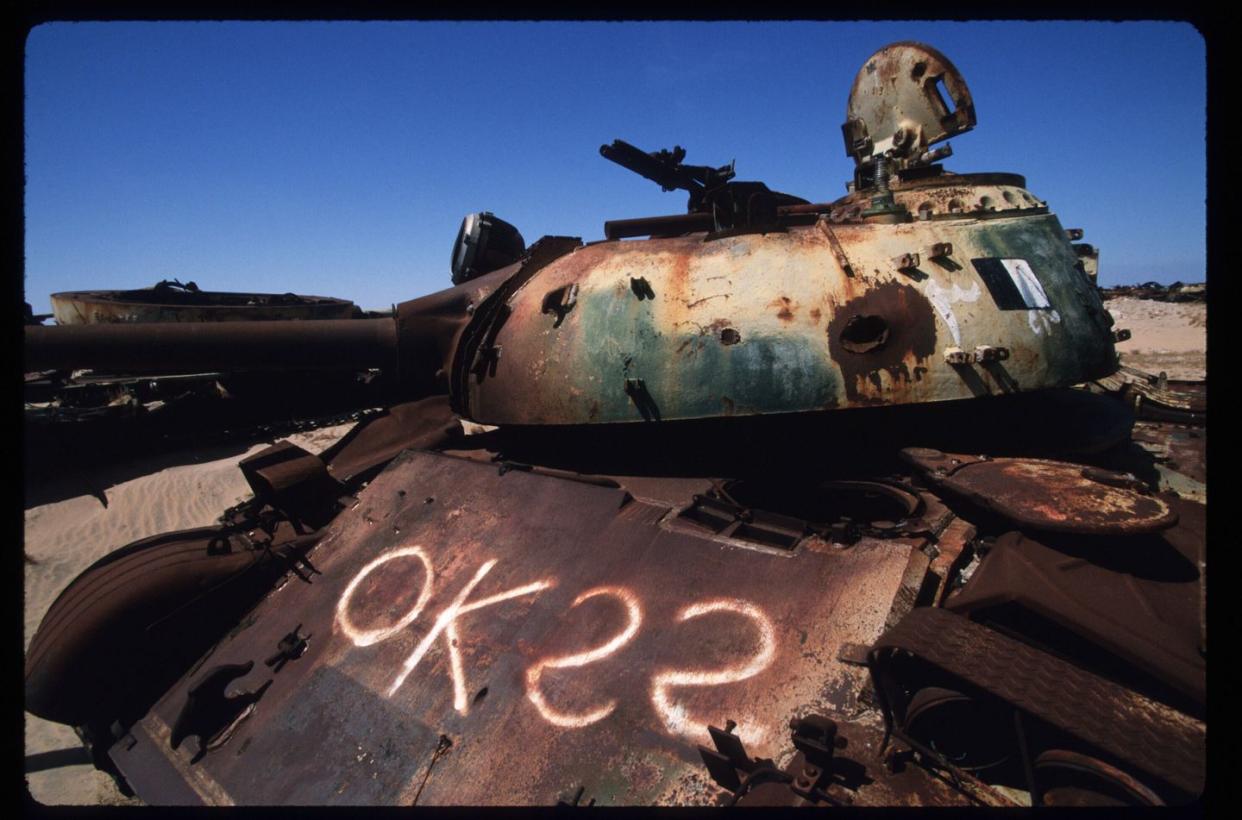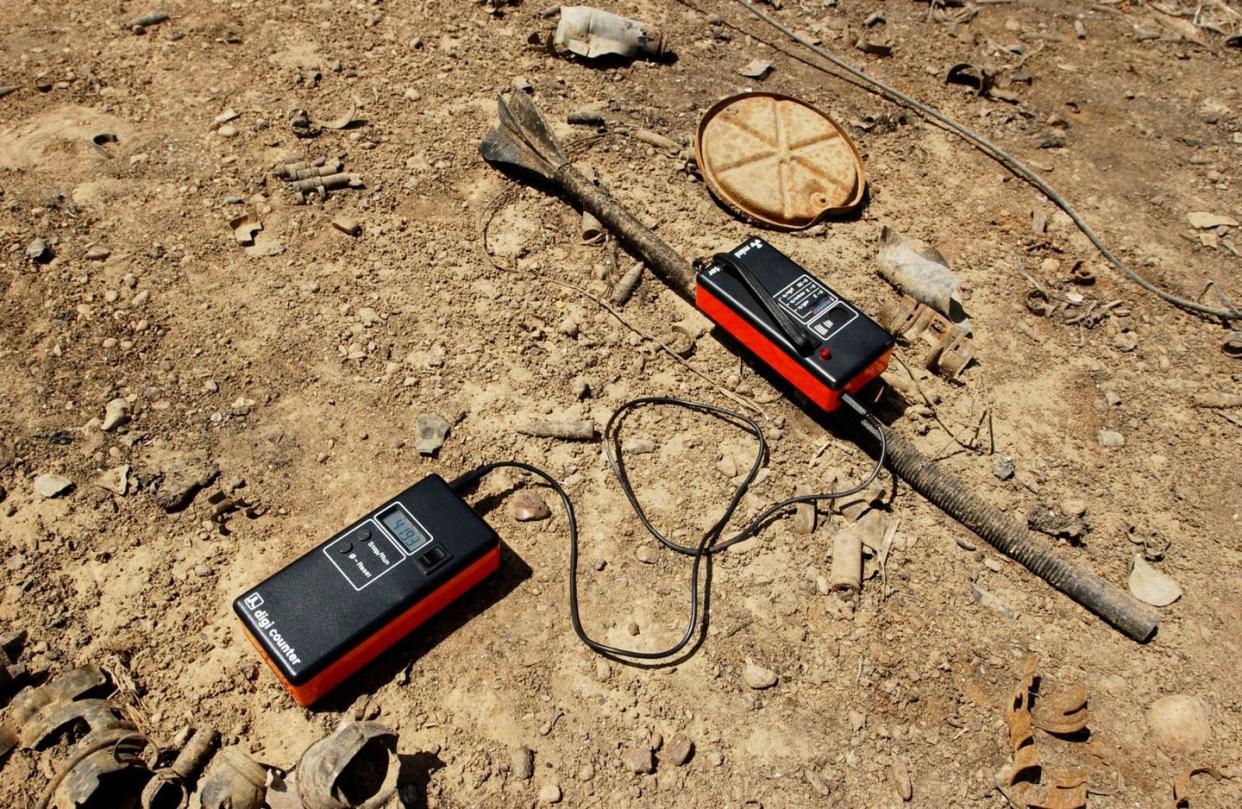No, Putin, Depleted Uranium Tank Shells Don't Justify Nuclear War

"Hearst Magazines and Yahoo may earn commission or revenue on some items through these links."
Thirteen months after initiating a massive invasion that has resulted in the deaths of tens of thousands of Russians and Ukrainians, Russian president Vladimir Putin is worried that a modest number of depleted uranium tank shells being supplied for 14 tanks donated to Ukraine amount to nuclear escalation.
“If all this happens, Russia will have to respond accordingly, given that the West collectively is already beginning to use weapons with a nuclear component,” Putin recently remarked ominously, following a meeting with Chinese leader Xi Jinping.
Later, a speaker in Russia’s parliament decried the move as a “tragedy on a global scale” likely to lead to a “sharp rise in oncological diseases.”
Putin’s invocation of the word “nuclear,” with the implication he might retaliate with a nuclear weapon himself, is the height of insincere bluster from a leader who spent months insisting he had no plans to invade Ukraine and who throws his citizens in jail for daring to call that conflict a war instead of a “special military operation.”
Putin is implying a type of shell designed to bust through heavy tank armor—and which has been in the arsenal of Russian, Ukrainian, and U.S. conventional forces for decades—is somehow equivalent to a nuclear weapon with a much broader destructive radius and greater radiological hazards.
After all, back in 2018, Russian state media boasted that a new Svinets-2 depleted uranium shell was entering service on Russian tanks, and that it “does not violate any international treaties.”
What is true is that DU shells have been controversial because they are lightly, but persistently radioactive and release a toxic dust mostly inside, but also in a narrow radius around, vehicles that have been struck by them.
There have been many allegations, including by local health professionals, that depleted uranium munitions employed in the Middle East and Balkans are responsible for rises in reported rates of cancer or birth defects. However, multiple studies have failed to establish causal links that DU munitions are causing such outcomes.
Nonetheless, it’s easy to evoke a reaction with images of horrifying birth defects and correlating it with the use of the ammunition somewhere in the vicinity.
In truth, the radioactivity and toxicity are separate phenomena. Scientists say the radiological impact is negligible and doesn’t penetrate human skin, contrary to hyperbolic claims that it’s highly radioactive.
Instead, it’s uranium’s toxicity as a heavy metal (like lead, for example) that poses real health risks. Even then, that toxicity isn’t unique to depleted uranium shells, as it’s manifested using non-radioactive tungsten shells widely used in all modern tanks.

Still, non-DU-using states have repeatedly sought to ban or indemnify their use. Such calls have been opposed or ignored by the states producing and using the ammunition, which include China, France, Pakistan, Russia, the U.S., and the U.K. Russia itself abstained from a U.N. vote seeking to ban their use in 2007.
CHARM: The Challenger 2’s Bespoke Depleted Uranium Ammo

The 14 Challenger 2 main battle tanks donated by the U.K. are armed with the sui generis 120-millimeter L30A1 55-caliber rifled gun, unlike smoothbores used in nearly all other modern tanks. It was designed from the onset to employ depleted uranium sabot shells defeating Soviet tank armor, alongside the multi-purpose L31A7 High-Explosive Squash Head round.
The depleted uranium L27A1, and the preceding L26A1, are armor-piercing, fin-stabilized, discarding sabot shells designed to maximize the kinetic energy of an arrow-like penetrator. After firing, the shell’s external casing blows off like the petals of a flower, leaving the slender penetrating dart with much of the energy, but not the drag-inducing weight of a larger munition.
Extreme density is critical to maximize the dart’s penetration, so the two preferred materials for the penetrator are tungsten or depleted uranium, the latter produced as a waste byproduct of uranium enrichment to fuel nuclear reactors or arm nuclear warheads. Also known as D-38, this substance has two-thirds greater density than lead and is less radioactive than naturally occurring uranium.

DU shells tend to out-penetrate tungsten equivalents, and are cheaper, too, as they’re a waste byproduct. Depleted uranium has an additional advantage: it’s pyrophoric, igniting on impact imparting combustive effects that increase the odds a penetrating shot destroys the target outright.

While tungsten isn’t radioactive, it’s also an extremely toxic carcinogen.
The Soviet Union started fielding depleted uranium 125-millimeter tank shells over 40 years ago starting with the 3BM29 Nadphil-2 and 3BM32 Vant, introduced in 1982 and 1985, respectively, followed by the 3BM48 in 1991. Currently, Russia’s Svinets-1 tungsten shell is complimented by the Svinets-2 DU shell, which boosts RHA equivalent penetration from 650 up to 750 millimeters, posing more of a threat even to well-armored Leopard 2 or M1 tanks.
While Russia obviously has stocks of these shells, Ukraine also likely retains the older 3BM32s. Both may already be using these shells in combat to help defeat modern tanks girded with more advanced types of explosive reactive armor that degrade kinetic shells, like Ukraine’s T-64BV model 2017 or Russia’s T-90A, T-90M, T-80BVM and T-72B3 series tanks.
The Pentagon stated in a briefing that it hasn’t provided any DU munitions to Ukraine. Time will tell if that changes when it delivers M1 Abrams tanks, which often are armed with M829-series DU ammunition specifically developed to defeat progressively more advanced types of Russian explosive reactive armor like Kontakt-5 and Relikt. A Pentagon spokesperson declined to clarify to the Associated Press whether those would be supplied, citing operational security.
The Bradley fighting vehicles supplied to Ukraine can also employ M919 discarding-sabot DU shells for their much smaller 25-millimeter autocannons, but these apparently haven’t been supplied so far, per the Pentagon’s statement.

The other major American weapon that uses DU shells is the GAU-8 Avenger 30-millimeter cannon on the A-10 ground attack jet, which isn’t being furnished to Ukraine.
Germany, meanwhile, doesn’t use or produce DU shells for the Leopard 1 and 2 tanks it’s donating to Ukraine, though DU munitions compatible with their 105- and 120-millimeter guns do exist.
Health Hazards
While encased in their sabots, studies have shown DU shells don’t pose a significant radiological hazard to those that handle them. But when the DU penetrator blasts into its target and ignites that, it releases an aerosolized ‘dust’ of uranium oxides that is toxic to anyone inside the unfortunate vehicle—but that’s only in addition to the many vastly more immediate and deadly effects of shell penetration.
Because the kinetic effects of tank shells are far more lethal (and intended) than the toxic ones, the International Court of Justice issued an advisory opinion in 1996 concluding such shells don’t count as nuclear weapons or otherwise violate the Geneva Convention, which forbids use of poisons/chemical weapons.
Opponents claim the use of DU munitions has a much broader environmental impact, and that increased mortality and birth defects in Iraq are caused by them (and presumably not myriad other factors). However, studies by the IAEA and UN didn’t find evidence of that, even amongst Gulf War veterans with fragments of depleted uranium in their bodies. Studies haven so far failed to find carcinogenic (i.e. cancer-causing) effects of uranium exposure.
A study by the U.K.’s Royal Society concludes the environmental impact and health risks were “very low for most soldiers on the battlefield and for those living in the conflict area,” though in “extreme conditions and under worst case scenarios,” there could be adverse effects on the kindeys and lungs.
Why Is Putin Upset?
Putin’s complaints about transfers of a type of ammunition already owned by both sides in Ukraine are disingenuous. He surely knows these are specialized anti-tank rounds that are in no way comparable to the military, political, or environmental impact of nuclear weapons.
Putin has shown little prior concern to radiological threats, with Russian mechanized troops without protective gain exposing themselves by digging into or kicking up contaminated soil around the “Red Forest” (which turned that color after dying from radiation exposure) in the Chernobyl exclusion zone earlier in the war.
In 2022, Russian forces for a period also played a game of nuclear chicken by deploying artillery dangerously close to the Zaporizhizhya nuclear power plant.
Concerns expressed by other Russian politicians regarding the long-term health impact on Ukraine are especially risible after Russia’s military has rained clouds of incendiary thermite on populated areas and employed thermobaric weapons with massive lethal blast radiuses in cities.
The average Ukrainian citizens faces far greater health risks from the thousands of Russian missiles and Iranian drones hurled into residential apartment blocks than from shells fired at tanks on the frontline.
This is, therefore, a fuss aimed at deterring or at least imposing political costs for Western arms transfers to Ukraine by falsely conflating a conventional weapon with a nuclear one.
That isn’t to deny that the effects of tanks shells on human bodies are horrible, as are the broad environmental impacts of large-scale, high intensity warfare. The best way to avoid them would be to withdraw invading forces from a fizzling war of conquest.
You Might Also Like
